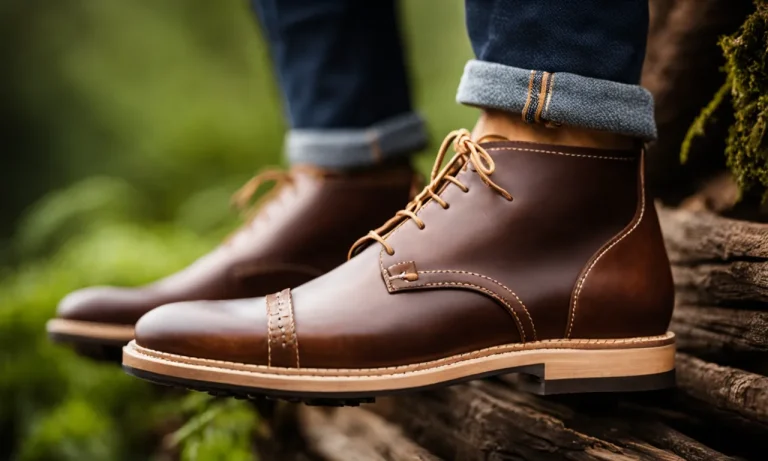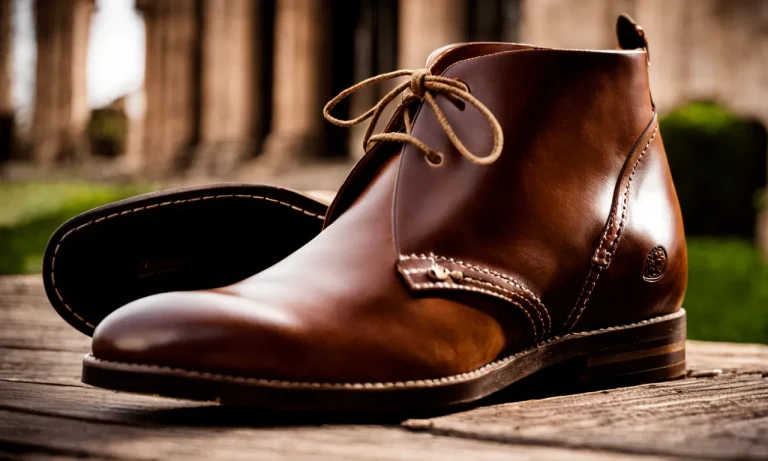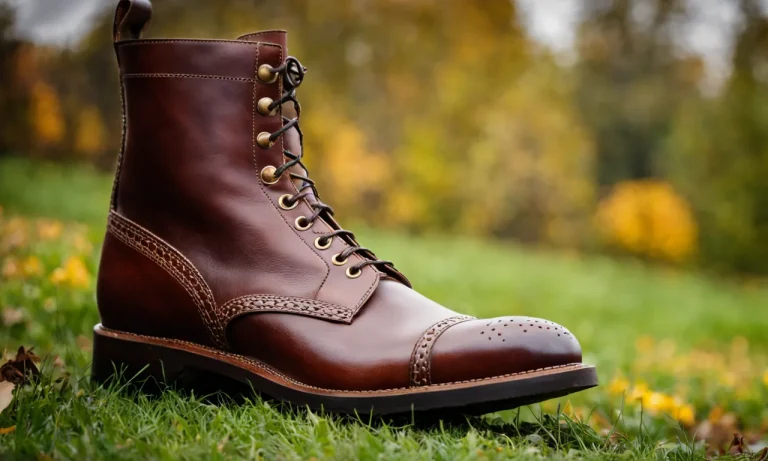If you’ve ever wondered whether to use shoe polish or shoe cream on your leather shoes, you’re not alone. With an array of products on the market promising to clean, condition, and shine your footwear, it can be tricky to know which is best.
If you’re short on time, here’s a quick answer: shoe creams are generally better for conditioning and nourishing leather, while polishes are primarily for adding shine and covering scuffs.
In this comprehensive guide, we’ll compare shoe polish and shoe cream in depth so you can decide which is right for your specific needs and footwear. We’ll cover the ingredients, application methods, use cases, pros and cons, and recommendations for popular shoe polish and cream brands.
After reading, you’ll be equipped with the knowledge to choose the proper products to keep your shoes looking their best.
What is Shoe Polish?
Shoe polish is a product that is used to enhance and protect the appearance of shoes. It is made from various ingredients such as waxes, dyes, and solvents. These components work together to provide a high shine and coverage to the shoes, making them look polished and well-maintained.
Made from waxes, dyes, solvents
Shoe polish typically contains a combination of waxes, dyes, and solvents. The waxes, such as carnauba wax or beeswax, help to create a protective layer on the shoes, preventing dirt, water, and other elements from damaging the leather.
Dyes are used to give the polish its color, allowing users to match the polish to the color of their shoes. Solvents are added to help the polish spread evenly and dry quickly.
Provides high shine and coverage
One of the main purposes of shoe polish is to provide a high shine and coverage to the shoes. When applied correctly, the polish can restore the original luster of the shoes, making them look as good as new.
It also helps to cover up any scuffs or scratches, giving the shoes a fresh and polished appearance.
Comes as paste, wax, liquid, spray
Shoe polish is available in various forms, including paste, wax, liquid, and spray. Paste and wax polishes are the most common and are typically applied using a brush or cloth. Liquid and spray polishes, on the other hand, offer a quick and convenient application method.
The choice of polish form depends on personal preference and the type of shoes being polished.
Better for smooth leathers
Shoe polish is particularly effective on smooth leathers. It helps to nourish and moisturize the leather, preventing it from drying out and cracking over time. However, it is important to note that shoe polish may not be suitable for all types of leather.
Certain delicate or exotic leathers may require specialized care and specific products. It is always recommended to check the manufacturer’s instructions or seek professional advice when unsure.
What is Shoe Cream?
Shoe cream is a product specifically designed to care for and maintain leather shoes. It is a type of shoe polish that is made from a combination of waxes, oils, and water. These ingredients work together to provide various benefits for your shoes.
Made from waxes, oils, and water
Shoe cream is formulated using a blend of waxes, oils, and water. The waxes in the cream help to create a protective layer over the leather, preventing it from drying out and cracking. The oils nourish the leather, keeping it soft and supple.
The water content helps to facilitate the application process and ensures that the cream spreads evenly over the shoe’s surface.
Conditions and nourishes leather
One of the primary functions of shoe cream is to condition and nourish the leather. The oils and waxes in the cream penetrate the leather, replenishing its natural oils and restoring its moisture balance. This helps to keep the leather looking great and prolongs its lifespan.
Comes as paste or wax
Shoe cream is available in both paste and wax forms. The paste version is easier to apply as it has a softer consistency, making it suitable for daily or regular use. On the other hand, the wax version provides a higher level of shine and is ideal for occasional use or when you want to achieve a more polished look.
Better for rough leathers
Shoe cream is especially beneficial for rough leathers, such as suede or nubuck. These types of leather have a more textured surface, and shoe cream helps to restore and enhance their appearance. The cream fills in any scuffs or scratches, making the shoes look refreshed and revitalized.
Ingredients
Shoe polish ingredients
Shoe polish is typically made up of a combination of waxes, solvents, and coloring agents. The waxes used in shoe polish help to create a protective layer on the surface of the shoe, preventing water and dirt from penetrating the leather.
Common waxes used in shoe polish include carnauba wax, beeswax, and paraffin wax. These waxes also give the shoes a shine and help to restore the color and luster of the leather. Solvents, such as turpentine or mineral spirits, are added to shoe polish to help dissolve the waxes and make them easier to apply.
Coloring agents are used to match the polish to the color of the shoe, ensuring a seamless finish.
Shoe cream ingredients
Shoe cream, on the other hand, is a more nourishing product that is designed to moisturize and condition the leather. It is typically made up of oils, waxes, and emulsifiers. The oils in shoe cream penetrate the leather, softening and moisturizing it to prevent cracking and drying out.
Common oils used in shoe cream include neatsfoot oil, mink oil, and lanolin. Waxes are also added to shoe cream to provide a protective layer and add shine. Emulsifiers are used to help blend the ingredients together and ensure easy application.
How ingredients impact performance
The choice between shoe polish and shoe cream ultimately depends on the specific needs of your shoes. Shoe polish is best suited for creating a high shine and protecting the shoes from water and dirt. It is great for dress shoes that need to look polished and professional.
Shoe cream, on the other hand, is ideal for nourishing and restoring the leather. It is perfect for older or dry shoes that require moisturization and conditioning. The different ingredients in shoe polish and shoe cream provide different benefits, so it’s important to consider the condition of your shoes and what you want to achieve.
Remember, always follow the instructions provided by the manufacturer when using shoe polish or shoe cream to ensure proper application and maximum effectiveness.
Application
How to apply shoe polish
Applying shoe polish is a simple process that can help restore the shine and protect the leather of your shoes. Here are the steps to follow:
- Clean your shoes: Before applying shoe polish, make sure to remove any dirt or dust from the surface of your shoes. You can use a damp cloth or a soft brush to gently clean the leather.
- Apply the polish: Take a small amount of shoe polish on a clean cloth or a brush and apply it evenly to your shoes. Use circular motions to rub the polish into the leather, paying extra attention to any scuffs or scratches.
- Let it dry: Allow the shoe polish to dry for a few minutes. This will allow the polish to penetrate the leather and create a protective barrier.
- Buff the shoes: Once the polish has dried, use a clean cloth or a brush to buff the shoes. This will help to bring out the shine and remove any excess polish.
How to apply shoe cream
Shoe cream is another popular product used to nourish and protect leather shoes. Here’s how you can apply shoe cream:
- Clean your shoes: Just like with shoe polish, it’s important to start with clean shoes. Use a damp cloth or a soft brush to remove any dirt or dust from the surface.
- Apply the cream: Take a small amount of shoe cream on a clean cloth or your fingertips and apply it to the leather. Gently massage the cream into the leather using circular motions.
- Let it absorb: Allow the shoe cream to absorb into the leather for about 5-10 minutes. This will help to nourish the leather and restore its natural oils.
- Buff the shoes: After the shoe cream has been absorbed, use a clean cloth or a brush to buff the shoes. This will help to bring out the shine and remove any excess cream.
Buffing techniques
When it comes to buffing your shoes, there are a few techniques you can use to achieve a great shine:
- Circular motion: Using a soft cloth or a brush, buff your shoes in a circular motion. This will help to distribute the polish or cream evenly and create a uniform shine.
- Back and forth motion: Another technique is to buff your shoes in a back and forth motion. This can help to remove any excess polish or cream and bring out a high shine.
- Pressure: Apply gentle pressure while buffing your shoes to create friction and heat. This will help to melt the polish or cream and create a smooth, glossy finish.
Frequency of application
The frequency of applying shoe polish or shoe cream depends on various factors such as the condition of your shoes, how often you wear them, and the type of environment they are exposed to. However, as a general guideline, it is recommended to polish or cream your shoes every 1-2 weeks for optimal maintenance and protection.
Regular application will help to keep your shoes looking great and extend their lifespan.
Use Cases
When to use shoe polish
Shoe polish is a great option when you want to give your shoes a polished and shiny appearance. It is ideal for formal shoes, such as dress shoes or oxfords, that require a high level of shine. Shoe polish typically comes in a variety of colors to match the shade of your shoes, allowing you to restore their original color and luster.
It also helps protect the leather from water and other elements, extending the lifespan of your shoes.
Shoe polish is particularly useful for leather shoes that have scuffs, scratches, or minor imperfections. The wax-based formula in shoe polish helps to fill in these imperfections and create a smooth surface.
Additionally, shoe polish can help restore the natural oils in leather, preventing it from drying out and cracking. It is recommended to use shoe polish once every few weeks or as needed, depending on the level of wear and tear your shoes experience.
When to use shoe cream
Shoe cream is a versatile option that can be used for both polishing and conditioning your shoes. Unlike shoe polish, shoe cream is available in a wider range of colors, making it easier to find a suitable match for your shoes.
It is particularly beneficial for casual shoes, such as loafers or sneakers, that don’t require a high shine.
Shoe cream is primarily used for nourishing and moisturizing leather. It helps to soften the leather, preventing it from becoming stiff and uncomfortable. Shoe cream also helps to restore the color and shine of your shoes, although it may not provide the same level of shine as shoe polish.
It is recommended to use shoe cream on a regular basis to maintain the quality and appearance of your shoes.
Consider leather type and condition
When deciding between shoe polish and shoe cream, it’s important to consider the type and condition of your leather shoes. If you have high-quality leather shoes that require a polished and shiny appearance, shoe polish is the better choice.
On the other hand, if you have casual leather shoes that need conditioning and a more natural finish, shoe cream is the way to go.
It’s also worth noting that certain leather types may respond better to shoe polish or shoe cream. For example, full-grain leather tends to work well with shoe polish, while softer leathers like suede or nubuck may benefit more from shoe cream.
It’s always a good idea to test a small area first and follow the manufacturer’s instructions to ensure the best results.
Ultimately, the decision between shoe polish and shoe cream depends on your personal preferences and the specific needs of your shoes. Whether you choose to use shoe polish or shoe cream, regularly caring for your shoes will help keep them looking great and extend their lifespan.
Pros and Cons
Shoe polish pros and cons
Shoe polish has been a popular choice for shoe maintenance for many years. Here are some of its pros and cons:
- Pros: Shoe polish provides a high shine and a polished finish to your shoes. It can help restore the color and shine of worn-out leather shoes, making them look new again. Shoe polish also provides a protective layer that helps repel water and prevent stains.
- Cons: One of the downsides of shoe polish is that it can sometimes leave a residue or build-up on the surface of the shoes. This can make the shoes look dull or sticky. Additionally, shoe polish may not be suitable for all types of leather and can darken certain shades of leather.
Shoe cream pros and cons
Shoe cream is another popular option for shoe care. Let’s take a look at its pros and cons:
- Pros: Shoe cream is known for its moisturizing properties, which can help nourish and condition the leather. It can also be used to restore the color and shine of leather shoes. Shoe cream is often easier to apply and spread evenly compared to shoe polish.
- Cons: While shoe cream provides a nice shine, it may not create as high of a shine as shoe polish. It also may not offer the same level of water resistance and stain protection as shoe polish. In some cases, shoe cream can darken the color of leather shoes.
Which is better for longevity?
When it comes to longevity, both shoe polish and shoe cream can help extend the lifespan of your shoes. However, the choice ultimately depends on your specific needs and preferences.
If you’re looking for a high shine and a polished finish, shoe polish may be the better option for you. It can provide a protective layer that helps repel water and prevent stains, keeping your shoes looking great for longer periods of time.
On the other hand, if you prioritize moisturizing and conditioning the leather, shoe cream may be a better choice. It can help keep the leather soft and supple, preventing cracks and prolonging the life of your shoes.
Ultimately, the best approach is to use a combination of both shoe polish and shoe cream. This way, you can enjoy the benefits of both products and ensure your shoes receive the care they deserve.
Popular Brands
Top shoe polish brands
When it comes to shoe polish, there are several top brands that have gained a reputation for their quality products. These brands include:
- Kiwi: Kiwi is a well-known brand that has been trusted for generations. They offer a wide range of shoe polish colors and formulations to cater to different needs.
- Saphir: Saphir is a luxury shoe care brand that is highly regarded for its premium products. Their shoe polishes are known for their high-quality ingredients and excellent results.
- Angelus: Angelus is a popular brand among sneaker enthusiasts. They offer a variety of shoe polishes, including specialty products for sneakers and leather sneakers.
Top shoe cream brands
When it comes to shoe cream, there are also several top brands that stand out for their quality and effectiveness. These brands include:
- Meltonian: Meltonian is a trusted brand that offers a wide range of shoe creams in various colors. Their products are known for their nourishing properties and ability to restore the natural shine of leather shoes.
- Collonil: Collonil is a German brand that is recognized for its high-quality shoe care products. Their shoe creams are formulated to provide deep conditioning and protection to leather shoes.
- Tarrago: Tarrago is a Spanish brand that is known for its innovative shoe care solutions. Their shoe creams are highly regarded for their ability to revive and rejuvenate leather shoes.
How to choose quality products
When choosing between shoe polish and shoe cream, it is important to consider the quality of the products. Here are a few tips to help you choose quality shoe care products:
- Read reviews and ratings: Before making a purchase, take the time to read reviews and ratings of the product. This will give you an idea of other customers’ experiences and the effectiveness of the product.
- Consider the ingredients: Look for products that contain high-quality ingredients that are known to nourish and protect leather. Avoid products that contain harsh chemicals that can damage the leather.
- Check for brand reputation: Opt for products from reputable brands that have a history of producing quality shoe care products. These brands have established themselves as leaders in the industry and are more likely to provide reliable products.
- Consult professionals: If you’re unsure about which product to choose, don’t hesitate to seek advice from professionals, such as shoe repair experts or shoe store employees. They can provide valuable insights and recommendations based on their expertise.
Remember, both shoe polish and shoe cream have their own benefits and uses. Ultimately, the choice depends on your personal preferences and the specific needs of your shoes. By choosing quality products from reputable brands, you can ensure that your shoes receive the care they deserve, keeping them looking great for years to come.
Recommendations
Best shoe polish for smooth leathers
When it comes to smooth leathers, it is essential to choose a shoe polish that not only provides a deep shine but also nourishes and protects the leather. One highly recommended option is Allen Edmonds Carnauba Shoe Polish.
This premium polish is made with carnauba wax, which creates a beautiful shine and forms a protective barrier against dirt and moisture. It comes in a variety of colors to match your shoes perfectly. Another great option is Kiwi Shoe Polish, which has been trusted by shoe enthusiasts for decades.
Their polish formula contains natural waxes to restore and enhance the leather’s appearance.
Best shoe cream for rough leathers
Rough leathers, such as suede and nubuck, require a different approach when it comes to maintenance. Instead of traditional shoe polish, it is best to use a shoe cream specifically formulated for these types of leathers. One highly recommended shoe cream is Angelus Easy Cleaner.
This cream is designed to gently clean and condition rough leathers without damaging or discoloring them. It effectively removes dirt, stains, and scuff marks, leaving your shoes looking refreshed and revitalized.
Another excellent option is Saphir Renovateur, a high-quality cream that not only cleans but also nourishes and protects rough leathers.
Tips for proper use
- Before applying any polish or cream, make sure to clean your shoes thoroughly to remove any dirt or debris. Use a soft brush or cloth to gently wipe away any surface impurities.
- Apply the polish or cream in small, circular motions, using a soft brush or cloth. This helps to evenly distribute the product and work it into the leather.
- Allow the polish or cream to dry completely before buffing it with a clean cloth. This will help to achieve a high shine and remove any excess product.
- For best results, apply a thin layer of polish or cream and repeat the process as necessary. Avoid applying too much product, as it can lead to a sticky or greasy residue.
- Store your shoe polish or cream in a cool, dry place to prevent it from drying out or losing its effectiveness.
Remember, the choice between shoe polish and shoe cream ultimately depends on the type of leather you are dealing with. Smooth leathers benefit from the shine and protection of shoe polish, while rough leathers require the gentle cleaning and conditioning of shoe cream.
By following these recommendations and using the right product for your shoes, you can keep them looking great and extend their lifespan.
Conclusion
When it comes to shoe polish versus shoe cream, neither product is universally better. The right choice depends on your specific footwear and needs. Polish offers excellent shine and concealment, while cream nourishes and conditions leather. For smooth leathers, reach for a quality polish.
For rough leathers, opt for a cream instead.
Now that you understand the ingredients, application, use cases, and brands for each product, you can make an informed decision. With proper care using the appropriate polishes and creams, your shoes will look great while the leather remains healthy.
Just be sure to always check the manufacturer’s guidance for your specific shoes.






